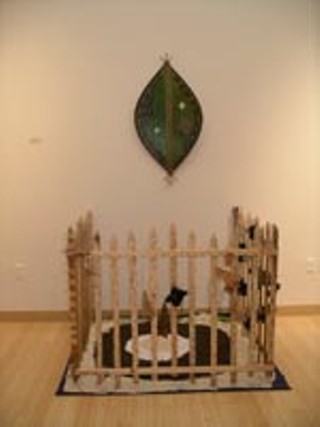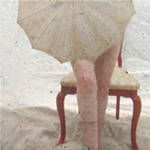‘Legacies of Dust’
The Carver Museum exhibition "Legacies of Dust" is a vital exploration, through the lens of daughterhood, of how memory functions and how selves are defined out of time, place, history, politics, sexuality, and community
Reviewed by Nikki Moore, Fri., June 23, 2006

"Legacies of Dust"
Artists Gallery at the Carver Museum & Cultural Center, through June 26
If you haven't been to the George Washington Carver Museum & Cultural Center yet, now is the time to go. The community emphasis of this venue makes it a testing ground for beginning artists and a spot for dialogue on works of longstanding strength and cohesion. "Legacies of Dust," featuring work by Austin artists, curated by the Carver's own Beatrice Thomas, explores daughterhood, memory, identity-in-the-making, and history, building off the timeless cinematic work of Julie Dash's film, Daughters of the Dust. The film and the burgeoning exhibited works both bridge from the story of the Sea Island Gullahs, a group of descendants from African captives who lived just off the mainland of South Carolina and Georgia at the turn of the century. As Daughters of the Dust illustrates, while early slave ships uprooted people from their land, communities, and practices for the economic advancement of the few, maintaining continuity with the past and with the familiar was possible for the Gullahs due, in part, to their physical isolation. Yet this story of cultural preservation, its compromises, and its vital role in remembering raises poignant questions about the present, dominated as it is by globalization and its effects. While the comparison needs further scrutiny, it is possible to look at the dark side of today's global economy as the slave trade's reverse, working via insertion rather than extraction: moving businesses into communities, lands, and practices where labor is cheapest and least regulated, and meanwhile breaking down lifestyles essential to the cultural preservation of the host peoples. While the merits and pitfalls of contemporary globalization can be argued from many angles, cultural erasures are certain occurrences in an increasingly global chain-store economy. Yet is there a possibility for memory, for legacy-building that doesn't require reversing the clock or pushing conservative agendas? Could daughterhood, could remembrance, could art be some of those possibilities, or are they too tainted?
In the works shown at the Carver by Constance Perez, hollow and bodied sculptures carrying backpacks or opening like small drawers depict daughters as vessels, as memory-holders, and this theme is carried in Ifaseye Sankofa's shrinelike collection of bottles standing in for dolls, standing in for selves, asking what it is we are filled with across time and place. The doll theme is shared more blatantly in the work of Ifaniike Sankofa, which examines the stereotypes of women, of daughters, and whose accompanying text reads like a young diary of the will to self-definition. Mother of the Sankofa twins, Nailah I. Sankofa looks at legacy symbolically, in a piece as much about motherhood as it is about the importance of ibeji in Yoruba tradition. In the exhibit's most prominent piece, Tonya Engel's site-specific work hangs from the ceiling in the shape of a dress on a hanger, the outfit composed of newspaper, wire, and tiny, open manila envelopes covered with quotes and scenes from Daughters of Dust, which she invites the public to stuff with their own statements. In this work, the subject is built communally, and selfhood happens in filling out or embodying the dress via the memories and descriptions of others. Yet the piece pushes back into a theme of self-determination in the writing on the hanger, so that metaphorically and in direct contra-distinction, the constructed self hangs on the will of the wearer.
Without calling in unnecessary value judgments, "Legacies of Dust" is a vital exploration, through the lens of daughterhood, of how memory functions and how selves are defined out of time, place, history, politics, sexuality, and community. While the show has roots in the past, there is no time like the present for the questions it raises.










